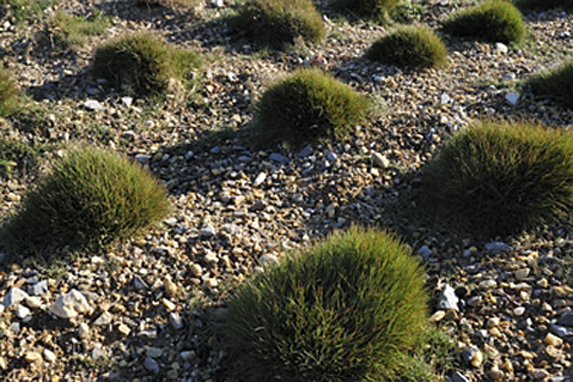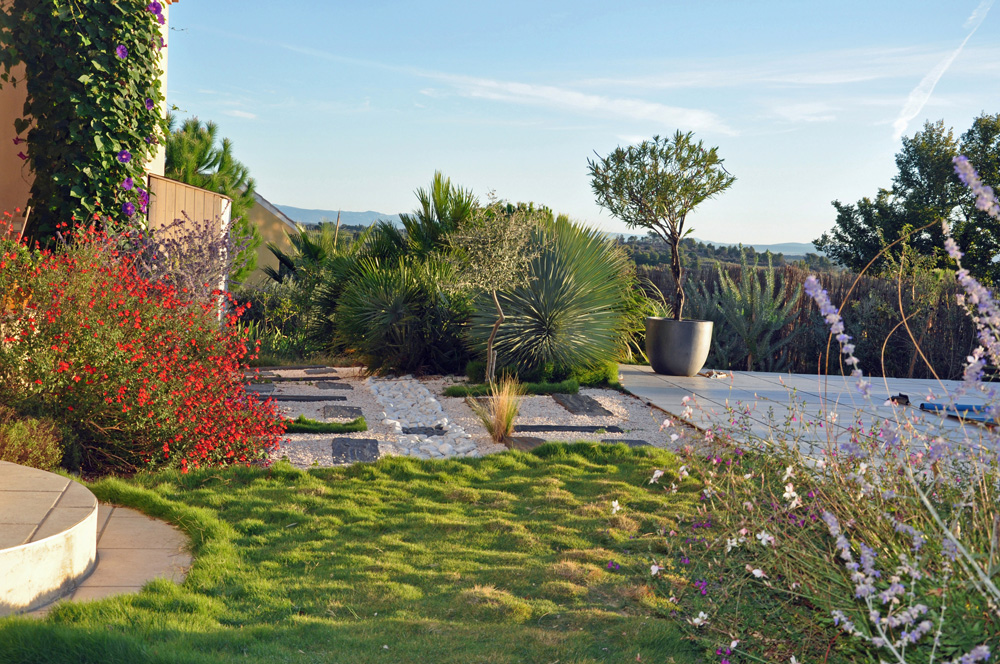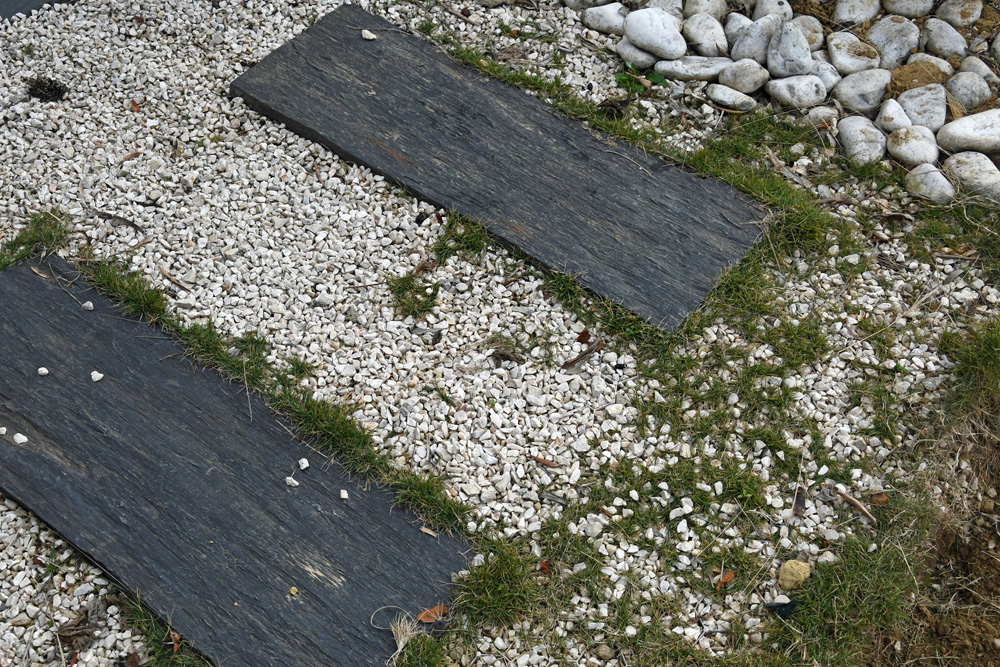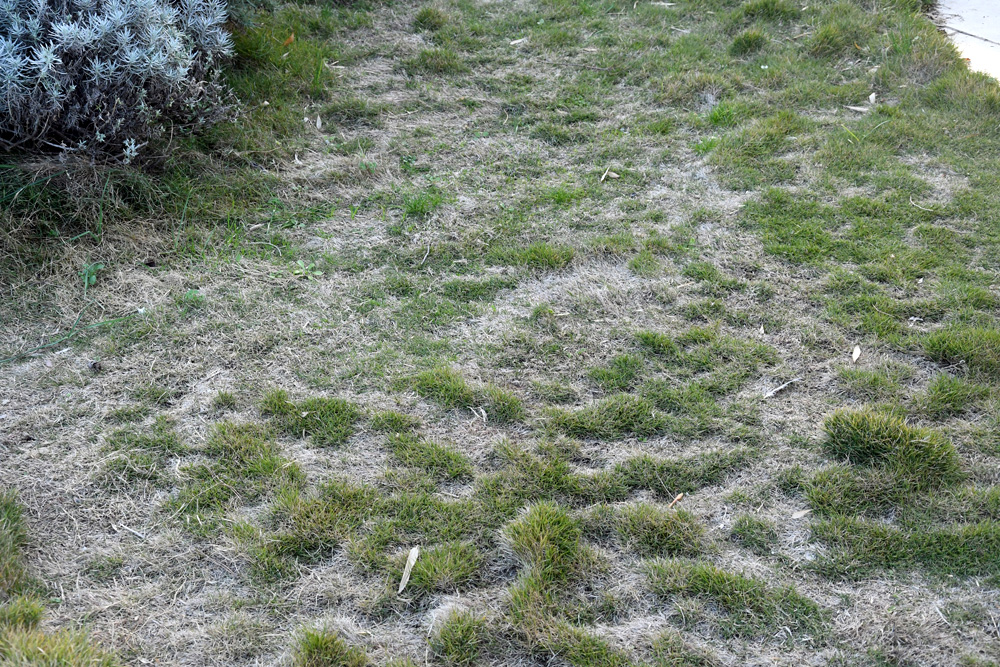Living with Zoysia
Ma vie avec Zoysia
Click on the images to enlarge them / Cliquez sur les images pour les agrandir
No, zoysia is not the love of my life. It’s just a grass, Zoysia tenuifolia, native to the Mascarene Islands (Reunion, Mauritius and Madagascar), which is an excellent alternative to lawns in Mediterranean climates. I’ve been using it for several years now. Here’s the story of our adventures.
Non, zoysia n’est pas l’amour de ma vie. C’est juste une herbe, Zoysia tenuifolia, originaire des Mascareignes (îles de La Réunion, Maurice et Madagascar), qui est une excellente alternative au gazon en climat méditerranéen. Cela fait plusieurs années qu’elle m’accompagne. Voici le récit de nos aventures.
Year 1 (2013) – Zoysia Disappointment
Expensive, ugly and hard to plant.
The area between the house and the pool is a 20 m2 lawn of couch grass and I decided to replace it with zoysia. Zoysia can’t be sown, so in the autumn I planted 6 small pots per m2 (120 pots, expensive!) after turning over the soil to carefully remove every last root of couch grass (tedious). Watering once a week is necessary, along with a little fertiliser to get things started. For a year, all I could see was a surface filled with sad, sparse clumps.
Année 1 (2013) – Déception Zoysia
C’est cher, laid et dur à planter.
Le passage entre la maison et la piscine est une pelouse de chiendent de 20 m2 et je décide de la remplacer par zoysia. Zoysia ne se sème pas et j’ai donc planté à l’automne 6 godets par m2 (120 godets, cher !) après avoir retourné la terre pour soigneusement enlever la moindre racine de chiendent (fastidieux). Un arrosage une fois par semaine est nécessaire ainsi qu’un peu d’engrais pour démarrer. Pendant un an, je n’observe qu’une surface peuplée de tristes touffes clairsemées.

Year 2 – Zoysia is lazy
Growth is slow and the surface is not completely covered. Careful weeding must continue.
Année 2 – Zoysia est paresseux
La croissance est lente et la surface n’est pas entièrement couverte. Il faut continuer à désherber soigneusement.
Year 3 – Zoysia is wonderful
Zoysia has finally covered everything, forming an attractive, bumpy ground cover. Weeding is a memory: hardly any weeds can grow between the tightly packed roots. There’s no need to mow the lawn: trampling is enough to keep the grass down. Children love this grass, which tickles the soles of their feet when they run barefoot. Cats are happy to scratch their claws in.
Année 3 – Zoysia est formidable
Zoysia a enfin tout couvert et forme un joli couvre-sol bosselé. Le désherbage n’est plus qu’un souvenir : quasiment aucun adventice ne peut pousser entre les racines serrées. Pas de tonte : le piétinement suffit à maintenir basse l’herbe. Les enfants adorent cette herbe qui leur chatouille la plante des pieds quand ils courent pieds nus. Les chats sont heureux d’y faire leurs griffes.
Year 6 – Zoysia does as it pleases
Three years later, zoysia has continued to grow and is spreading in places where it is undesirable, forcing me to do the hard work of pulling out the roots. In other places, however, I take advantage of its ability to spread, for example to occupy the gaps between the stone slabs.
Année 6 – Zoysia n’en fait qu’à sa tête
Trois ans plus tard, zoysia a continué de pousser et s’étend dans des endroits où il est indésirable m’obligeant à un difficile travail d’arrachage des racines. Par contre à d’autres endroits, je profite de sa faculté à s’étendre, par exemple pour occuper les interstices entre les dalles de pierre.
In conclusion
I love the bumpy appearance of this ground cover, its beautiful green colour from May until early winter, its tolerance of alkaline soil, the very low maintenance and its longevity. What I don’t like is the laborious installation work in the 1st year, the yellowing in winter, its tendency to spread inexorably (I’ve installed 25cm-high barriers but it manages to climb over them if you’re not careful) and you still have to water it once a week in summer (in the Hérault region). During a period of water restriction, it doesn’t die but turns yellow.
En conclusion :
J’adore l’aspect bosselé de ce couvre-sol, sa belle couleur verte à partir de mai jusqu’en début d’hiver, la tolérance au calcaire, l’entretien très réduit et sa longévité. J’aime moins la laborieuse installation la 1ère année, le jaunissement en hiver, sa propension à s’étendre inexorablement (j’ai installé des barrières de 25 cm de haut mais il arrive à passer par-dessus si l’on ne surveille pas) et il faut quand même arroser l’été une fois par semaine (dans l’Hérault). En période de restriction en eau, il ne meurt pas mais devient tout jaune.
Texte: Roland Leclercq
Photos: Roland Leclercq et Olivier Filippi
![]()




